As I walked into my living room, the warm light from the overhead lights welcomed me. It made the room feel cozy. But, I couldn’t help but wonder: was this light good for the planet? With our growing concern for the environment, we need eco-friendly lighting more than ever.
Changing our homes to be more sustainable is a big step. By choosing energy-efficient lighting, we can cut down on carbon emissions. We also save money and make our homes greener. Let’s dive into the world of sustainable lighting. We’ll find out how energy-efficient lighting can make your green home illumination shine bright.
Key Takeaways
- Discover the environmental impact of traditional lighting systems and the compelling benefits of switching to green lighting solutions.
- Explore the cutting-edge advancements in smart LED technology and their role in the future of home illumination.
- Learn how to maximize natural daylight in your living spaces through strategic window placement and innovative light-enhancing materials.
- Familiarize yourself with a wide range of eco-friendly lighting options for every room in your home.
- Understand the cost-saving potential of energy-efficient bulb types and the long-term financial benefits of sustainable lighting.
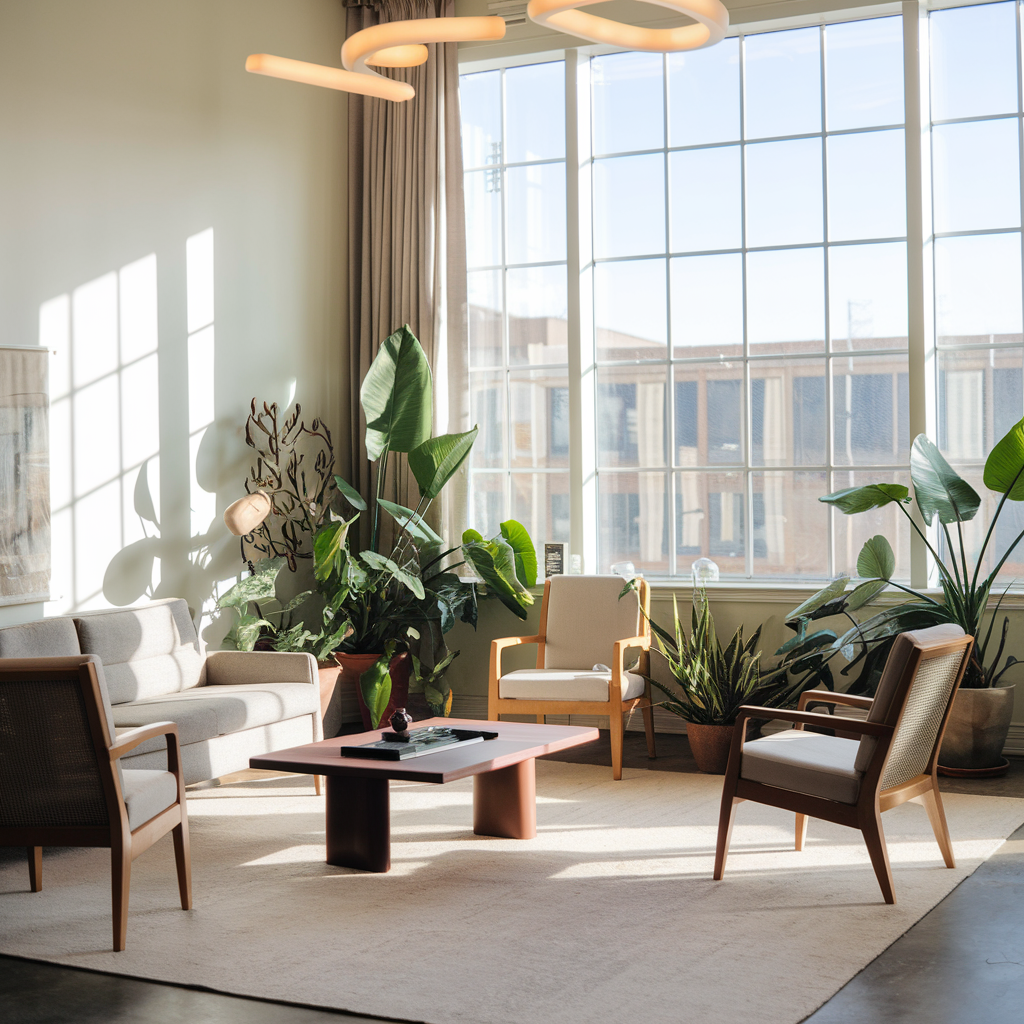
Here are all the products listed below, in case you’re interested
– Indoor Plant
– Coffee Table
– Wooden Flame Chair
– Large Soft Rugs for Living Room Vintage Beige
– Beige Sofa
Understanding the Importance of Sustainable Home Lighting
The world is getting more aware of saving the environment. This makes sustainable home lighting very important. Old lighting systems use a lot of energy and harm the planet. But, using eco-friendly lighting can help make our homes greener and save money.
Environmental Impact of Traditional Lighting Systems
Old light bulbs, like incandescent and halogen, use a lot of energy. They waste a lot of power, only making a little light. This not only hurts the environment but also makes our electricity bills higher.
Benefits of Switching to Green Lighting Solutions
- Less energy used and lower bills
- Less pollution and a smaller carbon footprint
- Bulbs last longer, so we throw away less
- Better energy use and light quality
- Can get government help and discounts
Energy Consumption Statistics in Home Lighting
Studies show that lighting uses about 15% of a home’s energy. This shows we need to use more energy-efficient lights. Switching to LEDs or solar bulbs can really help the planet and save us money.
“Using eco-friendly lighting is good for the planet and can save us money in the long run.”
Smart LED Technology: The Future of Home Illumination
Homeowners are looking for eco-friendly lighting, and smart LED lights are leading the way. These energy-efficient LED bulbs are long-lasting and versatile. They also bring intelligence and connectivity to our homes.
Smart LED home lighting works well with smart home systems. You can control your lights with your phone or voice commands. This lets you set the mood and save energy.
These bulbs save a lot of energy. They use up to 80% less power than old lights but shine just as bright. This means lower bills and a smaller carbon footprint for your home.
As more people use smart LED lights, our homes will become even smarter. Lighting will add to our comfort, convenience, and help the planet.
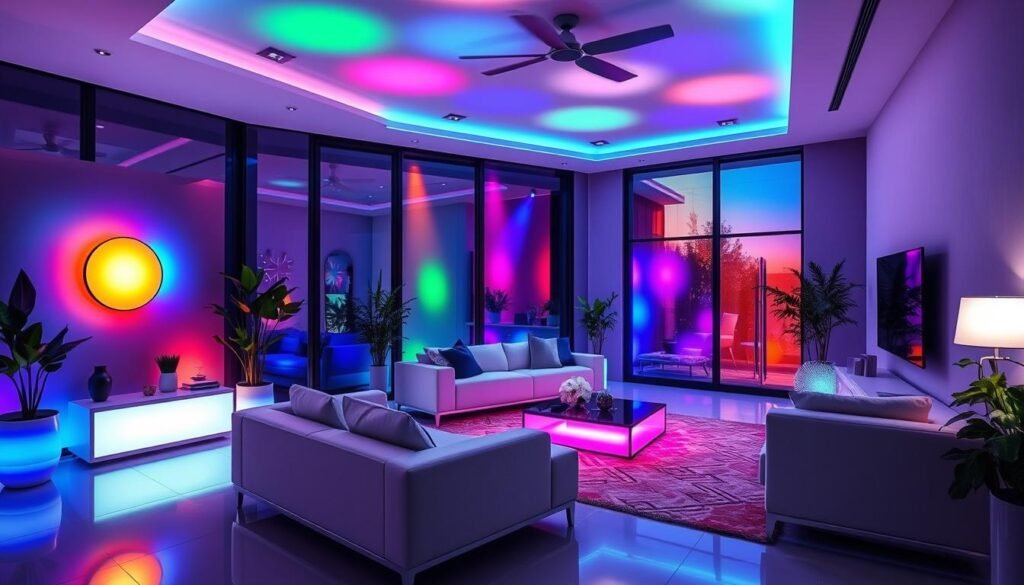
“The future of home lighting is undoubtedly smart and energy-efficient, and smart LED technology is at the forefront of this revolution.”
Natural Light Optimization: Maximizing Daylight in Your Space
Using natural light is a smart way to save energy and be kind to the planet. By making the most of daylight, you can use less artificial light. This means you’ll use less energy and harm the environment less.
Strategic Window Placement
Where you put your windows is key for getting more natural light. Place them to catch the sun’s rays all day. Think about the sun’s path, your home’s direction, and your windows’ size and shape to let in more light.
Light Tubes and Solar Tunnels
If your home doesn’t get direct sunlight, light tubes and solar tunnels are great. They use mirrors to send sunlight from the roof to your home. This makes for a bright, green lighting option.
Reflective Surfaces and Materials
Using reflective materials can boost your home’s natural light. Light-colored walls, ceilings, and floors reflect light well. This makes your home feel brighter and more welcoming.
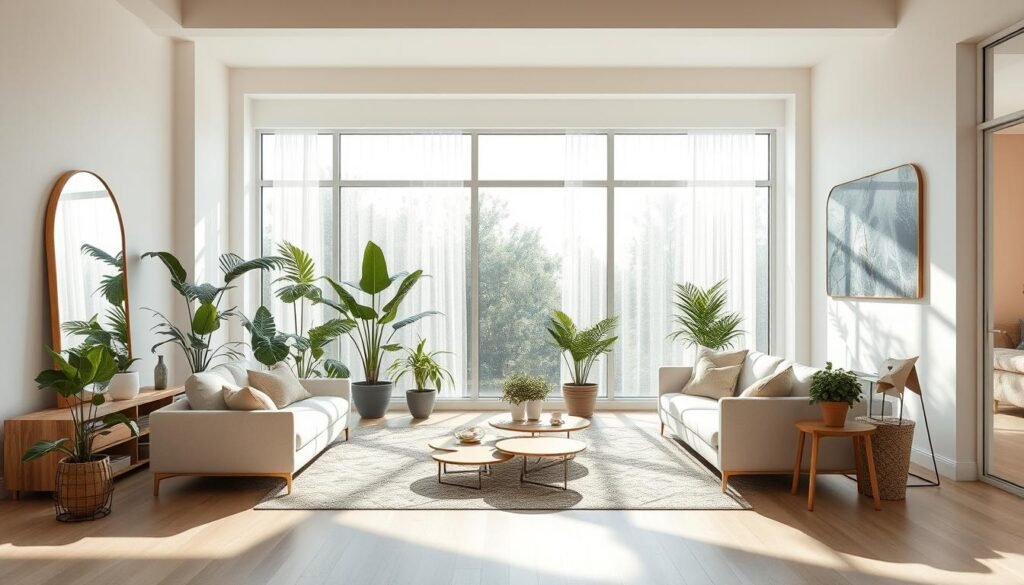
Here are all the products listed below, in case you’re interested
– Beige Sofa
– Coffee Tables set
– Wood Arched Framed Wall Mounted Vanity Mirror
By using these tips, you can make your home brighter with natural light. This reduces your need for artificial light. It makes your home more energy-efficient and eco-friendly.
Eco-Friendly Lighting Options for Every Room
Starting a sustainable home begins with smart lighting choices. Whether you’re building or updating, eco-friendly lighting can make your space better and greener. Let’s look at the top options for each room.
Living Room Lighting
In the living room, pick room-specific lighting that looks good and works well. Eco-friendly light fixtures like LED lamps and dimmable sconces save energy. Add bamboo or recycled materials for a green touch.
Kitchen Lighting
The kitchen needs both task and ambient light. Use LED lights under cabinets for work areas. Choose pendant lights or overheads that dim for the perfect light for cooking and dining.
Bathroom Lighting
In the bathroom, aim for even, clear light. LED vanity lights or recessed lights with dimmers are great. Match these with wood or stone for a natural look.
Bedroom Lighting
Bedrooms need layered lighting. Use reading lamps, dimmable overheads, and soft accents. LED bulbs and eco-friendly light fixtures create a calm, energy-saving space.
By using room-specific lighting, eco-friendly light fixtures, and sustainable home design, you can make your home green and efficient.
| Room | Eco-Friendly Lighting Options | Benefits |
|---|---|---|
| Living Room | LED floor lamps, recessed lighting, dimmable wall sconces | Enhance ambiance, reduce energy consumption |
| Kitchen | LED under-cabinet lighting, dimmable pendant lights | Provide task and ambient lighting, improve energy efficiency |
| Bathroom | Wall-mounted LED vanity lights, dimmable recessed lighting | Create a spa-like atmosphere, reduce energy use |
| Bedroom | Task lamps, dimmable overhead fixtures, accent lighting | Promote relaxation, enhance energy efficiency |
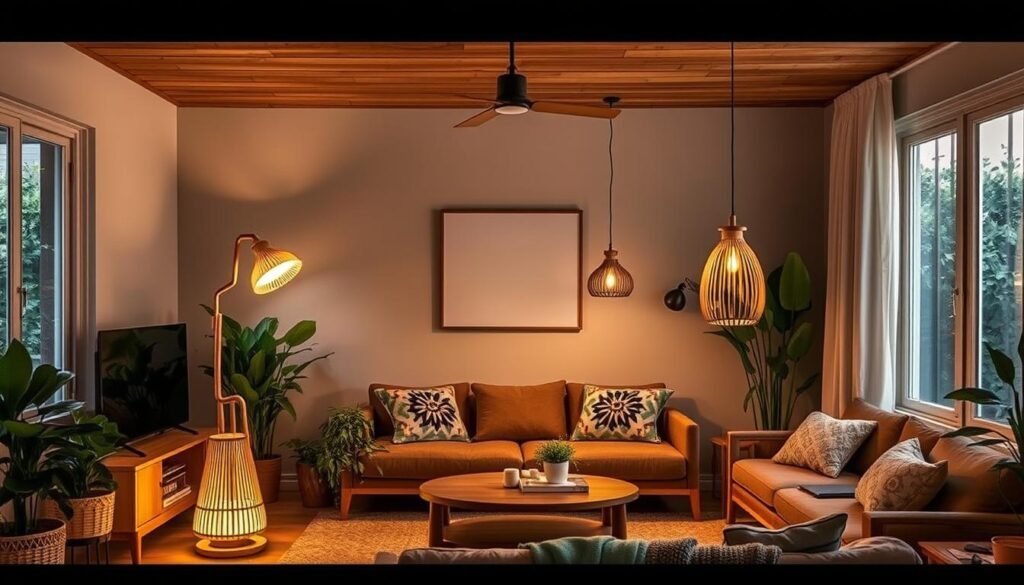
“Sustainable lighting choices not only reduce your environmental impact but can also enhance the overall aesthetic and functionality of your living spaces.”
Energy-Efficient Bulb Types and Their Applications
Homeowners are looking for ways to cut down on energy use and lower bills. Choosing the right lighting is key. There are many energy-saving bulbs out there, each with its own benefits. Let’s look at the main differences between LED, CFL, and traditional bulbs to guide your choice.
LED vs. CFL vs. Traditional Bulbs
LED bulbs are leading the way in energy-saving lighting. They use up to 80% less energy than old incandescent bulbs and light up just as well, sometimes better. CFLs are also energy-efficient but cost more than LEDs. LEDs last longer and use less energy, making them a better choice.
Lifespan and Cost Comparison
How long a bulb lasts is important for saving money. LEDs can go up to 50,000 hours, much longer than CFLs and incandescent bulbs. Even though LEDs cost more upfront, their long life and energy savings add up to big savings over time.
Color Temperature and Mood Impact
The color of a bulb’s light affects the mood of a room. Warmer lights, from 2,700K to 3,000K, make a space feel cozy. Cooler lights, from 4,000K to 6,500K, energize and focus. Choosing the right color can change the feel of your space.
“Upgrading to energy-efficient lighting can be one of the easiest and most cost-effective ways to reduce your home’s environmental footprint.”
Solar-Powered Lighting Solutions for Indoor and Outdoor Spaces
More and more people want to live in a way that’s better for the planet. Solar-powered lights are a big step in that direction. They use the sun’s energy, making them a green and affordable choice compared to old lighting systems.
Looking to light up your backyard or a cozy spot inside? Outdoor solar lighting and indoor solar lamps are great options. They use the latest solar panel tech to store energy during the day. Then, they light up automatically at night, saving you money and energy.
- Easy installation, with no wiring or electrical work required
- Reduced energy costs and lower carbon emissions
- Durable and weatherproof construction for long-lasting performance
- Customizable lighting settings to suit your preferences
There’s a wide range of solar-powered lights out there, from modern to whimsical. They fit any style and can make your home look great while being kind to the planet. This way, you can enjoy a beautiful and eco-friendly space, inside and out.
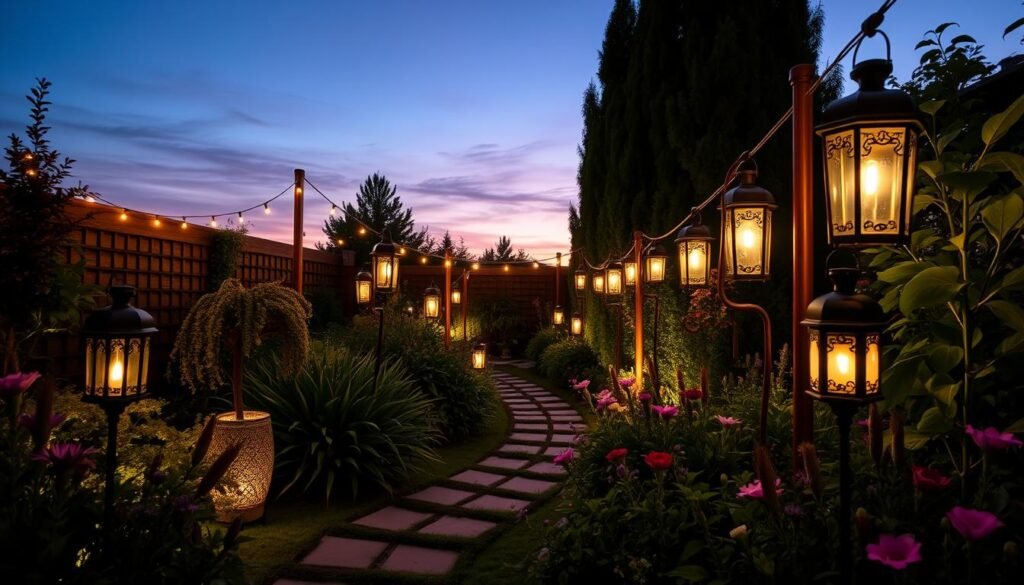
“Solar power is the future of home lighting. It’s clean, cost-effective, and allows us to harness the abundant energy of the sun.”
More and more homeowners are choosing solar-powered lights for their homes. They want to save energy and help the environment. By using these lights, you can do the same and make your home look great too.
Smart Home Integration for Optimal Light Management
The future of home lighting is smart and connected. Homeowners can now manage their lighting systems easily. This is thanks to advanced smart home lighting technologies. These include motion sensors, timers, mobile app controls, and energy monitoring systems.
Motion Sensors and Timers
Motion sensors are a key part of automated light control systems. They turn lights on or off when they detect movement. This saves energy in rooms that are not being used.
With customizable timers, homeowners can set lighting schedules. This fits their daily routines and helps save energy.
Mobile App Controls
Smart home lighting can be controlled from your phone. Homeowners can adjust brightness, color, and schedules from their smartphones or tablets. This makes managing energy use easy and convenient.
Energy Monitoring Systems
Energy monitoring systems give insights into lighting usage. They help homeowners make smart choices to reduce their environmental impact. These systems track energy use in real-time.
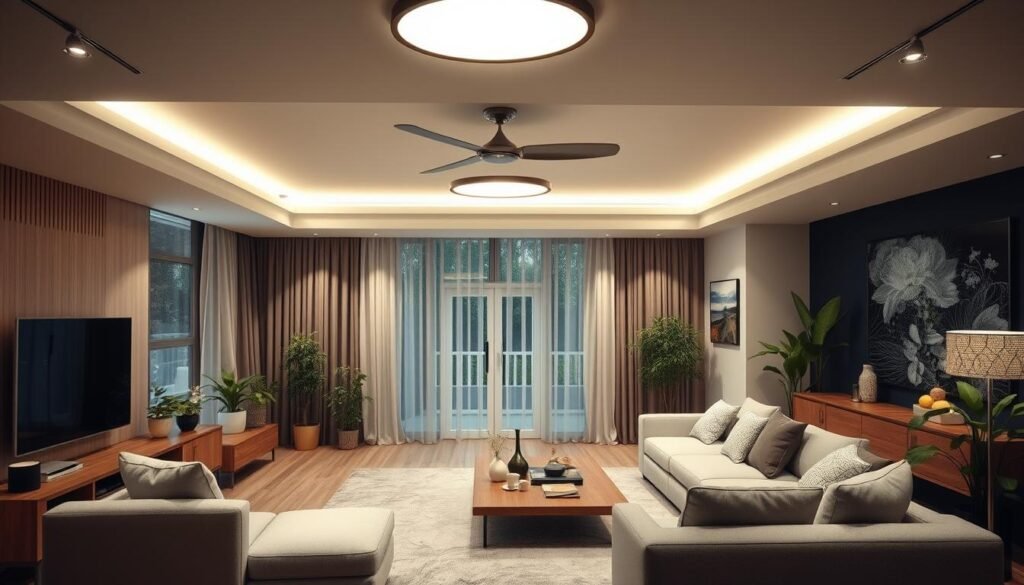
Smart home technology opens up a new world of sustainable lighting. It makes homes more comfortable and helps the environment. It’s a step towards a more energy-efficient future.
Cost Analysis: Long-term Savings with Green Lighting
Homeowners often think about the cost of switching to eco-friendly lighting. They wonder if the initial cost is worth it. But, the long-term savings and return on investment (ROI) make it a good choice.
Let’s look at the costs of eco-friendly lighting costs and the big energy-saving calculations. These can lead to big ROI on green lighting.
Upfront Costs and Energy Savings
Eco-friendly lighting, like LED bulbs, costs more upfront than old bulbs. But, they use much less energy. This means you’ll pay less for electricity each month.
| Lighting Type | Upfront Cost | Energy Consumption | Annual Energy Savings |
|---|---|---|---|
| Incandescent Bulb | $1.00 | 60 watts | $0 |
| LED Bulb | $10.00 | 10 watts | $50 |
LED bulbs cost more at first, but save a lot of money over time. You can save $50 a year with each bulb.
Calculating the ROI
To figure out the ROI on green lighting, follow these steps:
- Find out how much eco-friendly lighting costs for your home.
- Figure out how much energy you’ll save each year with the new lighting.
- Divide the cost of the lighting by the energy savings to find out how long it’ll take to pay back.
- The longer the lighting lasts, the more money you’ll save in the long run.
By looking at the eco-friendly lighting costs, energy-saving calculations, and ROI on green lighting, you can decide if it’s right for you.
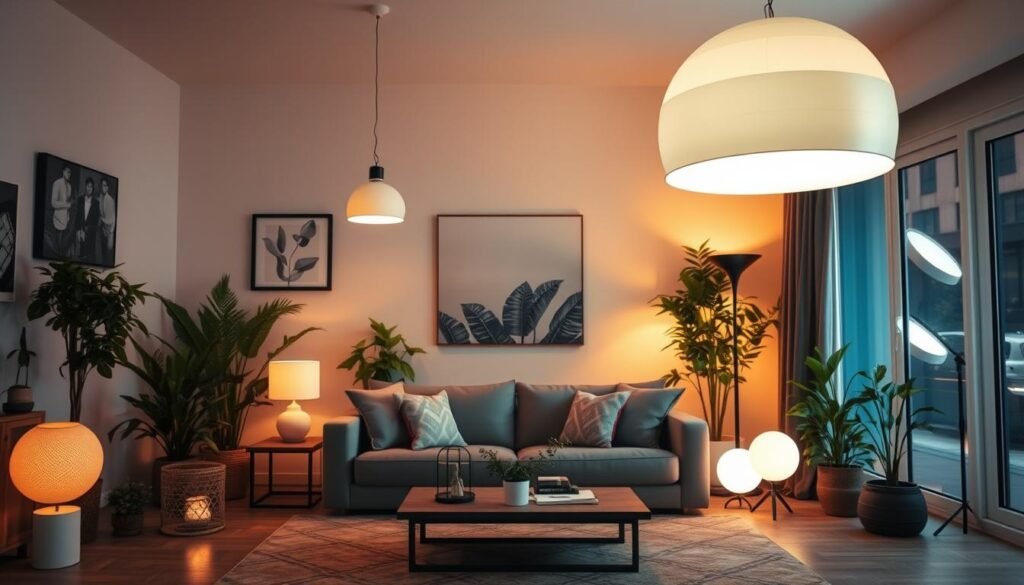
“Investing in eco-friendly lighting is not only environmentally responsible but can also lead to significant long-term financial savings for homeowners.”
Government Incentives and Rebates for Eco-Friendly Lighting
Switching to energy-efficient lighting is a smart move for homeowners. It’s good for the planet and can save money. Thanks to government programs and utility company offers, making this change is easier and more affordable.
Federal Tax Credits
The U.S. government gives tax credits for installing energy-saving lighting. These credits can lower the cost of switching to LED or other efficient bulbs. Homeowners should talk to a tax expert to see if they qualify and how to claim the credits.
State-Specific Programs
Many states also offer programs to encourage energy-efficient lighting. These can include rebates, grants, or other financial help. By looking into these programs, homeowners can save even more when they switch to green lighting.
Utility Company Rebates
Utility companies also provide rebates and discounts for energy-efficient lighting. These programs aim to promote sustainable practices and cut down energy use. Homeowners should reach out to their local utility companies to find out what’s available in their area.

Hello, I’m Jane, founder of Home Vibe Ideas. I’m here to inspire stylish Home Design, modern Smart Living, beautiful Outdoor Spaces, and creative DIY Projects to help you create a home that’s uniquely yours.
Disclosure: This post contains affiliate links. If you click on a link and make a purchase, we may earn a small commission at no additional cost to you. The content on this site was created with the help of AI technology.


